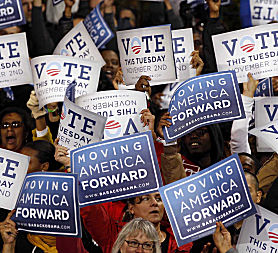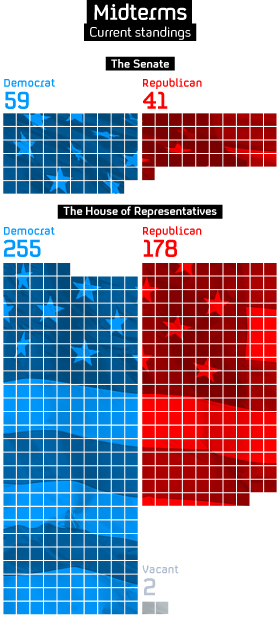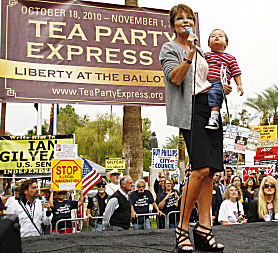US midterm elections 2010: your questions
Channel 4 News takes you through the key points of America’s midterm elections.

What are the midterm elections?
Every two years all 435 members of the House of Representatives – the lower house of Congress – stand for re-election. Around a third of the seats in the Senate, 37 out of 100 this year, are up for grabs – along with 37 Governorships.
In off years – ie when there is no presidential election – they are known as midterms. The system is designed to make sure not everyone stands for office at the same time.
Senators serve a six-year term to show that they are more prestigious political figures – and provide a more deliberative view, while the House reflects a more regular snapshot of the popular mood.

Why are the midterms important?
Although President Obama himself isn’t standing – the fate of his entire agenda is at stake. At the moment – his Democratic party controls the White House and both houses of Congress, a rarity in American politics which normally favours a more divided government.
If he no longer controls Congress, it’ll be almost impossible for the president to push through his policies – although the level of party discipline is far less than in the UK, and there’s a lot more horse-trading and compromising that has to go on before most major proposals become law.
The majority party also gets to hold the powerful offices in Congress – including committee chairs – which gives them huge scope to drive the legislative agenda.
When asked, most Americans tend to say they prefer a divided government, when a different party controls the White House and Congress. But back in 1994 – when Newt Gingrich’s Republicans swept to victory in Congressional elections – the result was gridlock: government services ground to a halt because President Clinton vetoed some of the budget cuts they were demanding.
What is expected to happen?
The Republicans need to win just 39 seats to win control of the House – and 10 to get a majority in the Senate. They’re unlikely to achieve the latter – but they’re predicted for a landslide in the House, as polls suggest they’ll pick up at least 50 seats, possibly a good deal more.
This isn’t unexpected for an incumbent party – and neither is a rather unenthusiastic electorate – turnout in midterm elections is typically around 40 per cent.
But this year the Republicans are proving far better at winning over the large number of independent voters – and galvanising their supporters to the polls.
This is largely due to the economic downturn: at times of hardship, the party in charge gets the blame – and a certain degree of disappointment in President Obama and the way he’s handled things.

What about the Tea Party members – who are they and are they likely to win?
The Tea Party is a right wing, popular movement that sprang up last year as a reaction to many of President Obama’s policies – chiefly his healthcare reforms, stimulus spending and financial bailouts.
It’s attracted high-profile figureheads like the former Alaska governor Sarah Palin – and its agenda is broadly one of limited government, fiscal responsibility and conservative social values.
While the Tea Party has managed to whip up a good deal of excitement among much of the Republican base – and helped the right recover from it’s overwhelming defeat in 2008 – it’s not all good news for the Republican party.
Tea Party insurgents like Christine O’ Donnell – running in Delaware – and New York’s Carl Paladino, are likely to lose what could have been winnable races.
Sharon Angle’s battle against Senate majority leader Harry Reid in Nevada is too close to call. And Joe Miller, in Alaska, ousted the incumbent Senator Lisa Murkowski – who’s running as a write-in, which could split the GOP vote. The same thing’s happening in Florida, where Charlie Crist is challenging the Tea Party’s Mark Rubio.
And Tea Party activists don’t agree with a fair few mainstream Republican positions, which could cause party leaders some headaches, trying to control them in Congress.
What will it mean for the Democrats, the Republicans and Barack Obama?
The Republicans were all but written off after 2008 – when the American political map turned blue with Democratic victories in states where they hadn’t been in with a chance for decades.
So this time, as the Democrats are staring ignominious defeat in the face, they might take comfort in the thought that there’s nothing America loves more than an underdog – and an unlikely comeback.
They’re also hoping that once the Republicans take charge of Congress, they’ll start sharing some of the blame for the country’s economic problems – especially once they start to rein in public spending.
As for the Republicans – there are plenty of tensions between the Tea Party activists and the mainstream – who’ll be keen to keep a lid on anything that might frighten off too many independent voters in 2012.
They’ll be trying to capitalise on the highly successful fundraising machines that have bankrolled this year’s candidates, to the tune of hundreds of millions of dollars.
For Barack Obama himself – it’s a steep challenge: overcoming the deeply divided political scene in Washington and beyond.
Working with a Republican majority that has declared itself intent on turning him into a one-term President, and repealing his flagship reforms. And forging a new White House team to carry him forward into the next presidential elections and beyond.
Some leading Democrats are even saying a Republican victory tomorrow could even help Obama’s chances in 2012 – especially if the GOP shifts too far to the right – leaving him to win back that crucial centre ground. Sarah Palin for President? That could be the ultimate Republican nightmare.




